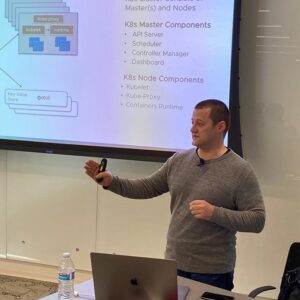|
|
 Yasen Simeonov Presents at Networking Field Day |
This Presentation date is February 14, 2020 at 14:30-17:30.
Presenters: Ashish Shah, Chandra Sekar, Ray Budavari, Yasen Simeonov
Follow on Twitter using the following hashtags or usernames: #NFD22
VMware NSX Networking and Security for Containers
Watch on YouTube
Watch on Vimeo
Organizations can leverage containers to simplify and accelerate application development. As the environment scales and grows, managing containers and microservices becomes increasingly difficult. This is where Kubernetes can help. NSX-T provides the enterprise class Networking and Security for Kubernetes and containers.
Personnel: Yasen Simeonov
VMware Demo: NSX Container Networking for Red Hat OpenShift 4.3
Watch on YouTube
Watch on Vimeo
- Automatically creates an NSX-T logical topology for an OpenShift cluster, and creates a separate logical network for each OpenShift namespace.
- Connects OpenShift pods to the logical network, and allocates IP and MAC addresses.
- Supports network address translation (NAT) and allocates a separate SNAT IP for each OpenShift namespace.
- Implements OpenShift network policies with NSX-T distributed firewall.
- Implements OpenShift Router with NSX-T layer 7 load balancer.
- Creates tags on the NSX-T logical switch port for the namespace, pod name, and labels of a pod, and allows the administrator to define NSX-T security groups and policies based on the tags.
Personnel: Yasen Simeonov
VMware NSX Intelligence: Network & Security Analytics for NSX
Watch on YouTube
Watch on Vimeo
NSX Intelligence is a distributed analytics engine built natively into NSX-T that provides continuous data center-wide visibility for network and application security teams, helping them deliver a more granular and dynamic security posture, simplify compliance analysis, and streamline security operations. NSX Intelligence provides deep insight at the packet level into virtualized and containerized workloads, allowing for intuitive, highly automated network and security policy generation and enforcement. NSX Intelligence helps eliminate blind spots to reduce security risk and accelerate security incident remediation through visualization and deep insight into every flow across the entire datacenter. Users gain holistic context for security troubleshooting and improve collaboration between infrastructure and security teams through a converged pane for security operations. Together with VMware vRealize Network Insight and NSX Intelligence, customers can gain comprehensive visibility, analytics and troubleshooting to improve network and security operations.
Personnel: Ray Budavari
VMware NSX Intelligence Demonstration and Key Integrations
Watch on YouTube
Watch on Vimeo
NSX Intelligence is a distributed analytics engine built natively into NSX-T that provides continuous data center-wide visibility for network and application security teams, helping them deliver a more granular and dynamic security posture, simplify compliance analysis, and streamline security operations.
Personnel: Ray Budavari
VMware NSX Advanced Load Balancer (Formerly Avi Networks)
Watch on YouTube
Watch on Vimeo
VMware’s acquisition of Avi Networks marked the company’s official entry into the load balancing industry. Traditional load balancers are hardware or virtual appliances are difficult to deploy, manage, and scale. NSX Advanced Load Balancer helps organizations overcome the complexity and rigidness of legacy systems and ADC appliances with modern, software-defined application delivery services. See why the world’s largest enterprises are replacing their legacy appliance-based load balancers with Avi Networks’ modern load balancing fabric across data centers and clouds. Avi separates the control plane from the data plane to create a fully elastic, multi-cloud load balancing fabric.
Personnel: Ashish Shah, Chandra Sekar
Demo: VMware NSX Advanced Load Balancer (Formerly Avi Networks)
Watch on YouTube
Watch on Vimeo
The VMware NSX Advanced Load Balancer (previously Avi Networks Platform) is a distributed application delivery controller (ADC) built for the cloud, with an architecture that mirrors cloud principles. NSX Advanced Load Balancer provides a software load balancer and intelligent web application firewall, combined with advanced analytics and monitoring to enable a fast, scalable, and intrinsically more secure application experience. The solution’s central control plane and distributed data plane deliver application services as a dynamic, multi-cloud fabric which intelligently automates decisions and provides unprecedented application analytics and on-demand elasticity. Customers can dispatch services, such as load balancing and web application firewall, to any application on any cloud, running on VMs, containers, or bare metal, using one centralized interface.
Personnel: Ashish Shah









